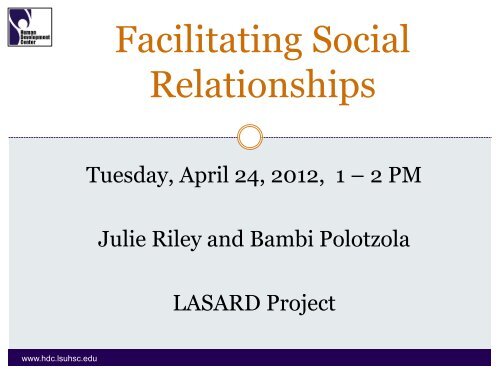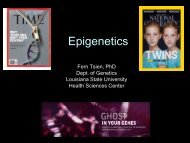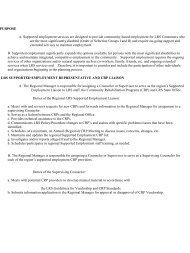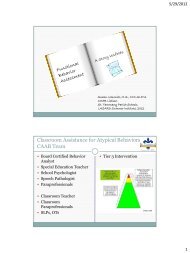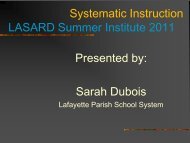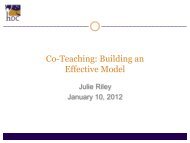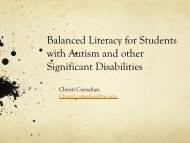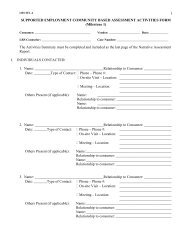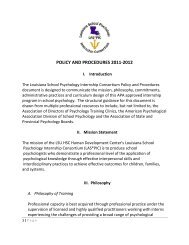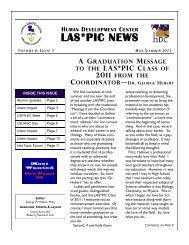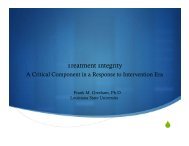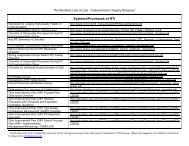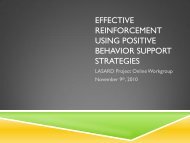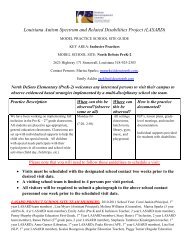Facilitating Social Relationships - LSUHSC Human Development ...
Facilitating Social Relationships - LSUHSC Human Development ...
Facilitating Social Relationships - LSUHSC Human Development ...
- No tags were found...
You also want an ePaper? Increase the reach of your titles
YUMPU automatically turns print PDFs into web optimized ePapers that Google loves.
<strong>Facilitating</strong> <strong>Social</strong><strong>Relationships</strong>Tuesday, April 24, 2012, 1 – 2 PMJulie Riley and Bambi PolotzolaLASARD Projectwww.hdc.lsuhsc.edu
In Today’s WorkgroupParticipants will: Understand facilitation of social relationships amongst peerswith and without disabilities. Learn strategies to facilitate social relationships. Observe an example of an intervention targeting thedevelopment of social relationships. Develop next steps for personal and team practice.www.hdc.lsuhsc.edu
www.hdc.lsuhsc.edu<strong>Facilitating</strong> <strong>Social</strong> <strong>Relationships</strong>
www.hdc.lsuhsc.eduhttp://www.merriam-webster.com/dictionary
www.hdc.lsuhsc.eduhttp://www.merriam-webster.com/dictionary
www.hdc.lsuhsc.eduhttp://www.merriam-webster.com/dictionary
<strong>Facilitating</strong> <strong>Social</strong> <strong>Relationships</strong>Help bringaboutCompanionshipwith friends orassociatesTowards a stateof being relatedor interrelatedwww.hdc.lsuhsc.edu
www.hdc.lsuhsc.eduWhy Is This Important?• <strong>Social</strong> interaction deficits are a central feature of autismspectrum disorders (ASD).• <strong>Social</strong> skills deficits can impede the development ofmeaningful relationships and can cause:◦ <strong>Social</strong> failure and isolation◦ Peer rejection◦ Depression◦ Substance abuse◦ Other forms of psychopathology• Having the necessary social skills will increase successwith relationships and positive social outcomes.Bellini, 2006
Disabilities and Friendships• Studies have concluded:◦ Individuals with ASD experience more loneliness thannondisabled peers. (Bauminger & Kasari, 2000)◦ Students with ASD would like more satisfying social peerinteractions, but do not know how to do so. (Bauminger,Shulman, & Agam, 2003)www.hdc.lsuhsc.edu
Disabilities and Friendships• Middle school students surveyed (Han & Chadsey,2004) reported they would like to be friends withstudents with disabilities, but they do not havefriends with significant disabilities because:◦ They do not see them◦ When they do see them, there is a paraeducator or other adultwith themwww.hdc.lsuhsc.edu
Stop and TalkWhat social skills are necessary to gain and maintainrelationships and social connections?‣ Example 1: A student falls on the playground and iscrying. He needs help to get the teacher’s attentionand feel better.‣ Example 2: A high school plans a social outing for aclub which includes: choosing a location, discussingplans for the outing, and participating in the trip.www.hdc.lsuhsc.edu
The Need for Facilitation• Students with ASD need specific, systematicinstruction on the attainment of social interactionskills and the performance of these skills.• Opportunities for instruction and interaction need tobe planned for and encouraged.(Bellini & Hopf, 2007 & Wang & Spillane, 2009)www.hdc.lsuhsc.edu
A Framework for PracticeOn-goingAssessmentPlanning forgeneralizationEvidence-basedPracticesLASARD, 2010Use of naturalsettings andactivitiesUse of same agepeerswww.hdc.lsuhsc.edu
Strategies for Facilitation• Using a team approach• Set clear, socially valid, goals and objectives• Develop a plan• Select best-fit, evidence-based strategieswww.hdc.lsuhsc.eduBellini, 2006
Strategies for Facilitation• Provide opportunities and instruction for interactions(this may include the use of prompting,reinforcement, self-monitoring strategies, andpriming).• Facilitate generalization• Progress monitor and adjust the plan, as necessary.www.hdc.lsuhsc.eduBellini, 2006
Finding Opportunities: Examples fromLASARD Partner School• Hahnville H.S.: Lunch and school clubs• Natchitoches Central High School: Generaleducation classroom, assemblies, and schooldances.• Pontchartrain Elementary: Recess and in generaleducation classrooms.• Ruston High School: “Drop Everything and Read.”• JB Martin Middle School: Advisory, lunch, andgeneral education classes.www.hdc.lsuhsc.edu
<strong>Facilitating</strong><strong>Social</strong> <strong>Relationships</strong>: A school example◦Assess the need(s)◦Implement intervention to facilitaterelationships◦Progress monitorwww.hdc.lsuhsc.edu
B.E. Boudreaux Middle School- Baldwin, LAwww.hdc.lsuhsc.edu
ASSESS the Need(s)◦ LASARD (Interdisciplinary) Team Meeting◦ Determine intervention to meet studentneeds: Peer Mediated Instruction &Intervention◦ Utilize planning tool to Select Peers andIdentify Objectiveswww.hdc.lsuhsc.edu
Interdisciplinary Team MeetingParaeducatorwww.hdc.lsuhsc.edu
Determine Intervention• Peer Mediated Instruction and Intervention1. Selecting peers2. Training peers3. Supporting peers4. Plan for implementation5. Implementation6. GeneralizationData collection throughout!Adapted from Neitzel (2008)www.hdc.lsuhsc.edu
www.hdc.lsuhsc.eduUtilize Planning Tool:Select Peers and Identify Objectives
Collaboratingwith familieswww.hdc.lsuhsc.edu
IMPLEMENT theIntervention(s)◦ Peer Training◦ Faculty Training◦ Student Interactionwww.hdc.lsuhsc.edu
Peer Training• Plan a training forPeer supports• Include information ongoals and desiredoutcomeswww.hdc.lsuhsc.edu
Peer Training• What does aninteraction look like?www.hdc.lsuhsc.edu
www.hdc.lsuhsc.eduGetting to Know One Another
www.hdc.lsuhsc.eduGetting to Know One Another
Building Capacity: Faculty Training• Classification of ASDs• Characteristics• IndividualizedEducationProgramming• Evidence-basedPracticeswww.hdc.lsuhsc.edu
Providing Opportunities for Interaction During class to classtransitions During lunch During extra-curricularactivitieswww.hdc.lsuhsc.edu
Progress Monitoring◦ Peer Support Meetings◦ Interview peers, target students, faculty, andstaff on successes and challenges◦ Collect data on goals and objectiveswww.hdc.lsuhsc.edu
Peer Support Meetings• Discuss interactions◦ What’s going well?◦ What do you need support in doing?Examples of discussion:CONCERN: Target student is “quiet”.PROBLEM SOLVING: Group brainstorms topics that she may interested in to engage herin conversation. Teacher provides input.SOLUTION: Peers will talk to Target student about music.CONCERN: Target student “doesn’t want to go to designated area” for their grade level.PROBLEM SOLVING: Teacher says that the Target student likes to go to another area.SOLUTION: Peers will meet her in her preferred area to build a relationship with her andthen try to move the interactions to the designated area.www.hdc.lsuhsc.edu
www.hdc.lsuhsc.eduInterview Participants
www.hdc.lsuhsc.eduSample Data Collection Template
Evidence-based Practices to Facilitate <strong>Social</strong><strong>Relationships</strong>• Naturalistic Intervention• Peer Mediated Instruction andIntervention• <strong>Social</strong> Skills Groups• Video Modelingwww.hdc.lsuhsc.edu(Simpson, de Boer-Ort, Griswold, Myles, Byrd, Gantz, et al., 2005)
Learning CheckWhat is the best strategy a team member can use toFACILITATE a social relationship:1. Bring a student to the playground2. Reinforce a positive interaction between peers3. Teach a social skills lesson in the classroom4. Give a student a story about being a good friend tootherswww.hdc.lsuhsc.edu
Learning CheckWhich of these indicates a positive outcome fromfacilitation?• A student is invited to a peer’s birthday party.• The student with ASD asks for and gets a friend’sphone number to call over the summer.• During lunch, a student with ASD goes to sit with agroup of peers without being prompted.• A student with ASD joins a school club based on acommon interest.• All of the above.www.hdc.lsuhsc.edu
Next Steps for Your Practice• Assess the needs of your student or child.◦ Ask: What skills does he need to form and maintainrelationships?• Determine an instructional plan.◦ Ask: What evidence-based practices and/or instructionalstrategies do I need to implement?• Find opportunities.◦ Ask: Where do typical students make friends and spend timewith them? What types of activities do they do together?www.hdc.lsuhsc.edu
Next Steps for Your Practice• Implement the intervention.◦ Ask: How will I know if this is working? What evidence should Ilook for and measure?• Generalize the skills of the student or child.◦ Ask: Can he build and keep relationships with multiple peoplein different settings and contexts?• Monitor progress.◦ Ask: Is he maintaining the skills over time? Is any otherinstruction or support needed at this time or in the future?www.hdc.lsuhsc.edu
Wrap-up• Students with ASD have core deficits in the area ofsocial interaction.• These students need instruction and support in orderto keep and maintain relationships.• Teams can facilitate social relationships through thesystematic interventions and by providingopportunities for instruction in typical settings withtypical peers.www.hdc.lsuhsc.edu
Where can I go for more information?• <strong>LSUHSC</strong> <strong>Human</strong> <strong>Development</strong> Center:www.hdc.lsuhsc.edu• National Professional <strong>Development</strong> Center onAutism Spectrum Disorders:http://autismpdc.fpg.unc.edu/• AIM Modules (OCALI):http://www.autisminternetmodules.org/Additional Questions? email: lasard@lsuhsc.eduwww.hdc.lsuhsc.edu
www.hdc.lsuhsc.eduQuestions, Comments, or Concerns?
References• Bauminger, N., & Kasari, C. (2000). Loneliness and friendship in high-functioning children with autism. Child<strong>Development</strong>, 71, 447–456.• Bauminger, N., Shulman, C., & Agam, G. (2003). Peer interaction with loneliness with high functioningchildren with autism. Journal of Autism and <strong>Development</strong>al Disorders, 33(5), 489-507.• Bellini, S. (2006). Building social relationships: A systematic approach to teaching social interaction skills tochildren and adolescents with autism spectrum disorders and other social difficulties. Shawnee Mission, KS:Autism Asperger Publishing Co.• Bellini, S., & Hopf, A. (2007). The development of the Autism <strong>Social</strong> Skills Profile: A preliminary analysis ofpsychometric properties. Focus on Autism and Other <strong>Development</strong>al Disabilities, 22, 80-87.• Kyoung Gun, H., & Chadsey, J. G. (2004). The Influence of Gender Patterns and Grade Level on FriendshipExpectations of Middle School Students Toward Peers with Severe Disabilities. Focus On Autism & Other<strong>Development</strong>al Disabilities, 19(4), 205-214.• Neitzel, J. (2008). Steps for implementation: PMII for elementary, middle, and high school. Chapel Hill, NC:National Professional <strong>Development</strong> Center on Autism Spectrum Disorders, Frank Porter Graham Child<strong>Development</strong> Institute, The University of North Carolina.• Wang, P., & Spillane, A. (2009) <strong>Social</strong> skills interventions for children with autism: A meta-analysis. Educationand Training in <strong>Development</strong>al Disabilities, 44(3), 318-342.www.hdc.lsuhsc.edu
Web References• Louisiana Autism Quality Indictors for Schools User’sGuide (2010). Retrieved from:http://www.hdc.lsuhsc.edu/lasard/pdf/User's_Guide_2010_CC.pdf• Merriam-Webster Dictionary (ND). Retrieved fromhttp://www.merriam-webster.com/dictionarywww.hdc.lsuhsc.edu


